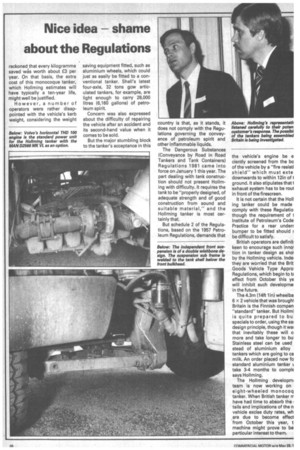Nice idea shame about the Regulations
Page 60

If you've noticed an error in this article please click here to report it so we can fix it.
reckoned that every kilogramme saved was worth about E3 per year. On that basis, the extra cost of this monocoque tanker, which Holiming estimates will have typically a ten-year life, might well be justified.
However, a number of operators were rather disappointed with the vehicle's kerb weight, considering the weight saving equipment fitted, such as aluminium wheels, which could just as easily be fitted to a conventional tanker. Shell's latest four-axle, 32 tons gcw articulated tankers, for example, are light enough to carry 28,000 litres (6,160 gallons) of petroleum spirit.
Concern was also expressed about the difficulty of repairing the vehicle after an accident and its second-hand value when it comes to be sold.
But the major stumbling block to the tanker's acceptance in this country is that, as it stands, it does not comply with the Regulations governing the conveyance of petroleum spirit and other inflammable liquids.
The Dangerous Substances (Conveyance by Road in Road Tankers and Tank Containers) Regulations 1981 came into force on January 1 this year. The part dealing with tank construction should not present Hollming with difficulty. It requires the tank to be "properly designed, of adequate strength and of good construction from sound and suitable material," and the Hollming tanker is most certainly that.
But schedule 2 of the Regulations, based on the 1957 Petroleum Regulations, demands that the vehicle's engine be e ciently screened from the be of the vehicle by a "fire resisti shield" which must exte downwards to within 12in of I ground. It also stipulates that I exhaust system has to be rout in front of the firescreen.
It is not certain that the Hall ing tanker could be made comply with these Regulatio though the requirement of 1 Institute of Petroleum's Code Practice for a rear under bumper to be fitted should be difficult to satisfy.
British operators are definit keen to encourage such inno, tion in tanker design as shol by the Hollming vehicle. lnde they are worried that the Brit Goods Vehicle Type Appro Regulations, which begin to tt effect from October this ye will inhibit such developme in the future.
The 4.3m (14ft 1in) wheelba 6 x 2 vehicle that was broughl Britain is the Finnish compan "standard" tanker. But Hollmi is quite prepared to bu specials to order, using the sa design principle, though it wal that inevitably these will cl more and take longer to bu Stainless steel can be used stead of aluminium alloy tankers which are going to ca milk. An order placed now fo standard aluminium tanker I take 3-4 months to complE says Hollming.
The Hollming developmi team is now working on eight-wheeled monocoq tanker. When British tanker rr have had time to absorb the tails and implications of the n vehicle excise duty rates, wh are due to become effect from October this year, t machine might prove to be particular interest to them.
































































